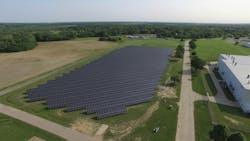2024 Airport Business Project of the Year: SPI Invests in Solar

Abraham Lincoln Springfield Airport (SPI) improved its bottom line and environmental impact for years to come thanks to a visionary project outside of traditional land development.
This groundbreaking initiative was the establishment of an airport-owned solar farm, an ambitious endeavor that would see the airport harness the power of the sun to fuel its future.
Nearly a decade ago, the leadership at SPI embarked on a journey to diversify the airport's revenue streams and effectively utilize idle land. This quest for innovation and sustainability led to the inception of the solar project.
Mark Hanna, the Executive Director of Springfield Airport Authority, said airport leadership were driven to find diverse revenue sources and leverage vacant land that posed developmental challenges.
“This was a perfect opportunity to leverage some vacant ground that we don't have any plans for development,” he said. “It's an awkward parcel that it's likely that that can be developed."
The project was rooted in practicality and vision. An approximately 12-acre parcel of land, once home to the airport's Aviation Fuel Farm, presented unique development difficulties due to its location and potential environmental concerns. Recognizing these challenges, the airport's leadership saw an opportunity to transform this idle land into a powerhouse of solar energy.
"We certainly started looking at the solar farm initiatives and understanding what developers were paying potentially at airports for use of their land,” Hanna said. “And the parcel that we had in mind... it's likely that that can be developed in a way that would generate substantial revenue."
The journey to realizing the solar farm at SPI was marked by meticulous planning and robust collaboration. Overcoming challenges such as supply chain issues and reengineering for accessible materials, the team demonstrated remarkable adaptability and resilience. Hanna emphasized the crucial role of collaboration, particularly with the utility company, to ensure smooth implementation.
The project was a joint venture with Veregy and involved numerous stakeholders, including service providers and tenants. This collaborative approach was vital in aligning various interests and technical requirements, showcasing a synergy of efforts towards a common goal.
The Solar Farm: A Beacon of Efficiency and Savings
The solar initiative at SPI is a marvel of engineering and environmental stewardship. Spread across three key locations, the project incorporates six solar arrays, both roof and ground-mounted, creating a 2.88 MW solar powerhouse. This endeavor is expected to cut electricity costs for several airport and tenant accounts by over 90%.
"It's equivalent energy savings as having 8,000,000 miles driven in a passenger vehicle each year. It's equivalent to 140,000 bags of trash going to a landfill instead of being recycled and about 4,000 acres of trees that would be saved it from the environment,” said Corey Harper, Aviation Sales Account Manager for Veregy.
What sets this project apart is its dual approach with Net Metering, benefiting both the airport and its tenants like StandardAero. The system, generating an impressive 4,200,000 kWh annually, stands as Illinois's largest airport-owned solar array for Net Metering. The project not only underscores SPI's commitment to the environment but also opens new avenues for revenue generation.
The implementation of the solar project required unique technical solutions to accommodate six locations with seven meters and large diameter wires. This complexity was further compounded by the need to coordinate with StandardAero, the FAA, and the city utility, highlighting the project's collaborative nature and technical prowess.
"We actually ended up making every connection to locations that helped us reduce our wire size,” Harper said. “That helped us reduce our equipment and it added some equipment as well."
The solar panels, guaranteed to produce for 25 years with minimal degradation, are a testament to the project's sustainability. The airport's integration of this project with broader sustainability goals, including those of the Springfield City Water Light and Power, illustrates a commitment to regional ecological initiatives.
Financial Viability and Strategic Planning
The financial aspect of the project was strategically managed, leveraging a mix of state and federal incentives. This approach reduced the airport's financing burden, highlighting the project's financial viability and effective resource utilization. The project's impact extends beyond the airport, benefiting tenants like StandardAero, who can now boast operations powered by 100% renewable energy.
Balance Solar provided a financing role to the project to offer about $1.3 million in savings to the project via a prepaid solar agreement, while covering the cost of the insurance and maintaining the system for seven years.
Zack Kearnan, Owner of Balance Solar, said the company provided additional savings to the project via its connections to tax equity investors as well.
“This project was 2.88 MegaWatts DC, so we were able to utilize our institutional investors,” he said. “Larger projects are generally easier because the appetite for those credits is much higher.”
The completion of the solar project at SPI is not just a milestone in sustainable airport infrastructure but a blueprint for future renewable energy initiatives. Hanna's integration of his experience in aviation and energy played a pivotal role in the project's seamless planning and implementation.
With a break-even point within the 20-year loan period and substantial long-term revenue projection, the project sets a precedent in balancing economic and environmental interests. As Hanna aptly noted, the project is not just an environmentally friendly energy source but a significant economic driver, retaining jobs and strengthening relationships with key stakeholders like StandardAero.
The solar system in Springfield isn’t the last innovation planned for the airport to tackle sustainability.
In recent years, SPI completed significant projects to update external and internal lighting with LED technology, replaced aged HVAC and mechanical systems with more high-efficient units, updated plumbing fixtures to conserve water and installed solar thermal collectors to assist with the hot water supply at the terminal.
Hanna said more solar collection facilities for electric generation are being contemplated along with EV charging stations that will hopefully be supplied, in part, with renewable power sources.
The airport just initiated a Smart Airport and Regional Logistics Planning Study that will further explore options for an on-airport microgrid as we plan for our future power needs and the expected proliferation of the electrification of aircraft powerplants,” he said.
- Location: Abraham Lincoln Capital Airport
- Project: Abraham Lincoln Capital Airport Solar Project
- Completion: March 2023
- Key Participants: Veregy LLC, Standard Aero, Balance Solar
- Cost: $6 million
About the Author
Joe Petrie
Editor & Chief
Joe Petrie is the Editorial Director for the Endeavor Aviation Group.
Joe has spent the past 20 years writing about the most cutting-edge topics related to transportation and policy in a variety of sectors with an emphasis on transportation issues for the past 15 years.
Contact: Joe Petrie
Editor & Chief | Airport Business
+1-920-568-8399
>> To download the AviationPros media kits, visit: Marketing Resource Center
>>Check out our aviation magazines: Ground Support Worldwide | Airport Business | Aircraft Maintenance Technology
